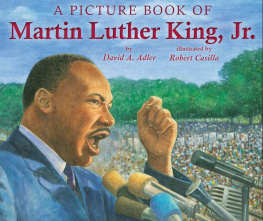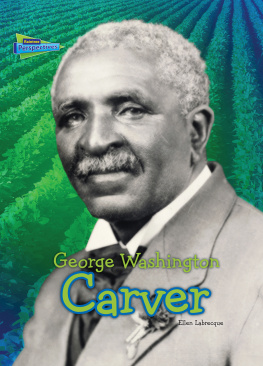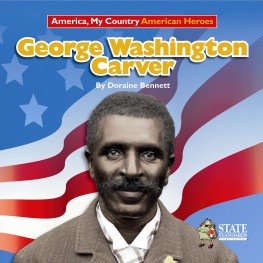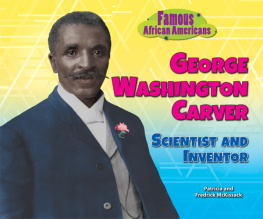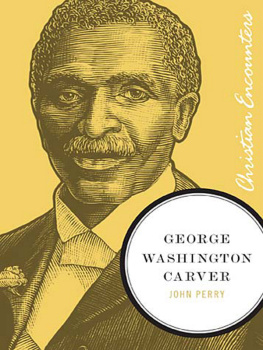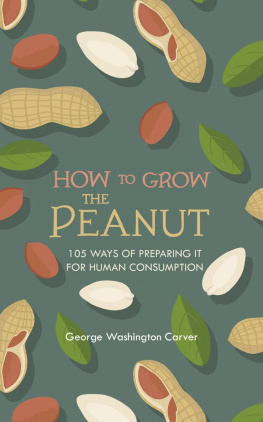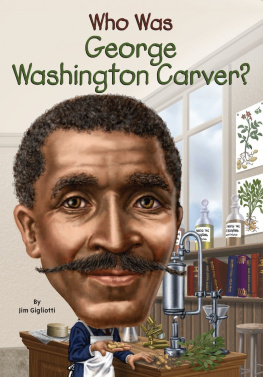George Washington Carver was born a slave. He was never sure of his birth date, just that it was in 1864 or early 1865, near the end of the Civil War. He was born on the Missouri farm of Moses and Susan Carver, where his mother, Mary, was a slave.
George hardly knew his mother. When he was an infant, raiders kidnapped him and his mother and took them to Arkansas. A neighbor found George and brought him home, but he didnt find Mary. Young George Washington Carver never saw her again.
Georges father was a slave, too, but George never met him. His father worked on a neighbors farm and was killed in an accident around the time George was born.
George and his brother, James, were raised by Moses and Susan Carver. The Carvers were good to the boys. George called Mr. Carver Uncle Mose.
George was not a strong boy. He wrote later that his body was in constant warfare between life and death. The Carvers did not make him work hard on the farm. He fed the animals and helped Susan Carver around the house. He had plenty of time to swim and explore the nearby woods.
George had his own little garden. He wrote later, I wanted to know every strange stone, flower, insect, bird, or beast, and Many are the tears I have shed because I would break the roots or flower off some of those pets. But he hid his garden in the brush because, It was consid-ered foolishness in that neighborhood to waste time on flowers.
The Carvers wanted him educated the same as white children.... They taught me to read, spell, and write just a little.
George needed to know more. His only book was a Web-sters Elementary Spelling Book. He read it so often, he knew it by heart. But that book had few answers for him.
When George was twelve, he went to a school for African American children in nearby Neosho. There he lived with Mariah and Andrew Watkins, a black couple. He paid for his room and food by helping around the house.
His aunt Mariah was a nurse. George learned from her which plants and herbs cure illnesses. She also taught him the value of time. Even during school recess, he had to run home to help Mariah with the laundry. There was no time for play.
The teacher in the Neosho school did not know much more than George. After less than a year there, George felt he needed to move on. He found a family on its way to Fort Scott, Kansas, almost one hundred miles away, and he hitched a ride.
In Fort Scott, George went to school, worked in a nearby grocery, and did laundry for people staying at the Wilder House, a hotel. He lived with a blacksmith and his family and helped out there, too.
In March 1879 in Fort Scott, a mob of masked white men pulled a black prisoner out of jail, tied him with a rope, and dragged him for five blocks. The prisoner was hanged and later burned. George Washington Carver witnessed that lynching and quickly left Fort Scott. The ugly memory of that night haunted George the rest of his life.
He went to Olathe, Kansas. From there he went to Paola, Kansas, and then to Minneapolis, Kansas, where he gradu-ated from high school.
Carver still had what he called the thirst for knowl-edge. In 1885 he applied by mail and was accepted to Highland University. But when he arrived to begin his studies, he was told that he could not attend the school because he was black.
George Washington Carver changed his plans. He be-came a farmer and bought land farther west. He built a one- room sod house with walls made of thick chunks of grassy dirt and a roof made of tar paper and dirt. He planted vegetables, studied art, and made friends.
But he became restless. He still had his thirst to learn. Carver traveled east to Iowa, and in September 1890 he enrolled in Simpson College. He was the schools first African American student. He studied art there, but soon realized he could do more for his people working with plants. He transferred to Iowa State College, where he studied agriculture.
At Iowa State, Carver joined debating, German, and art clubs. He became a trainer for the schools football team and held prayer meetings. God and religion were always important to him. When he studied nature, he felt he was getting closer to God by learning more about His creations.
George Washington Carver graduated from Iowa State in 1894 and became the schools first African American teacher. He also continued his studies. By 1896 he had earned a master of science degree.



